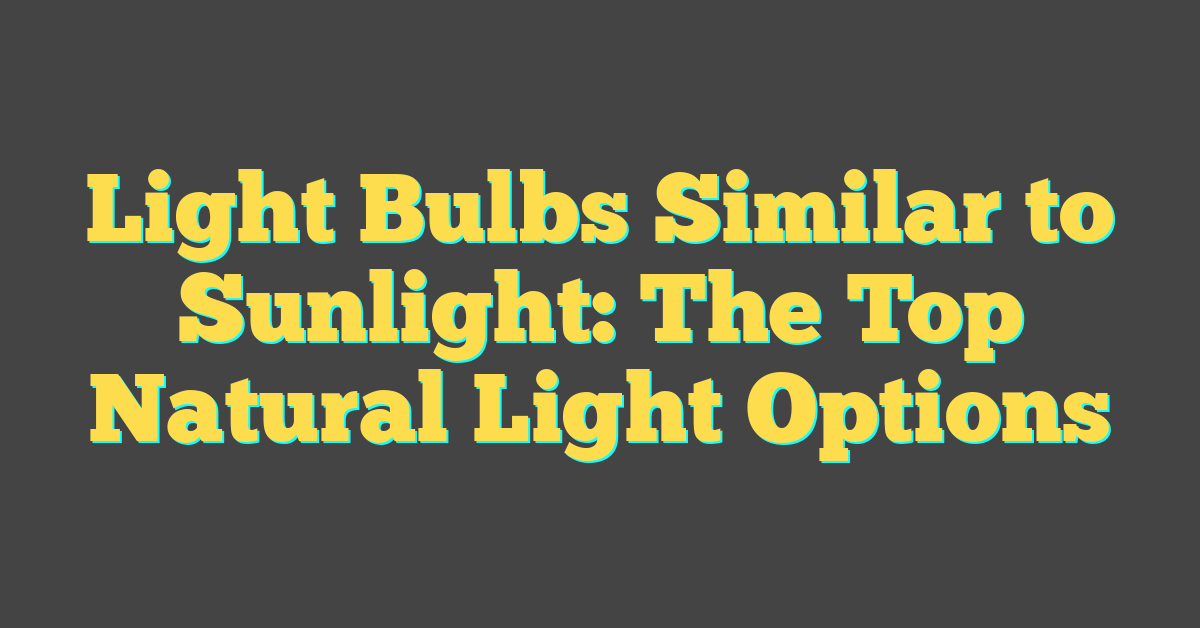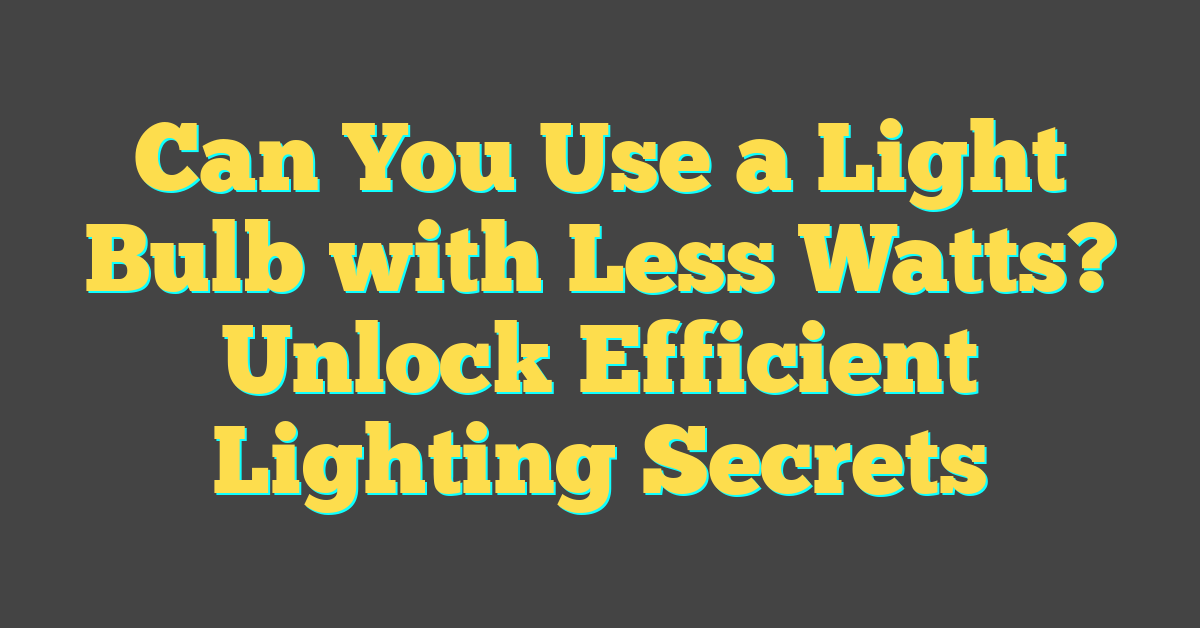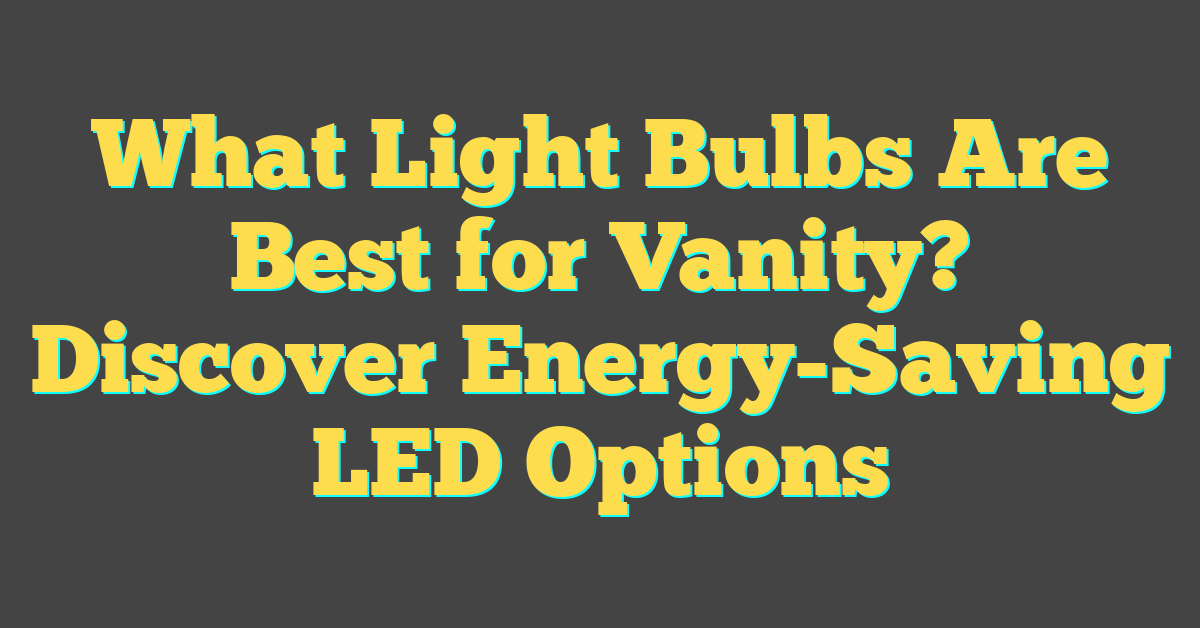Exposure to natural sunlight has numerous benefits, influencing both our health and well-being. However, not every space we inhabit benefits from abundant natural light. This is where light bulbs that simulate sunlight come into play, offering a practical solution for indoor environments that lack exposure to actual sunlight. By mimicking the full spectrum of sunlight, these light bulbs attempt to recreate the lighting conditions found outdoors, impacting our spaces in terms of aesthetics and functionality.


When searching for light bulbs akin to natural sunlight, it’s important to consider factors such as the Color Rendering Index (CRI), which indicates how natural objects appear under the artificial light in comparison to genuine sunlight. In addition, various types of light bulbs, such as LEDs and fluorescents, provide different levels of energy efficiency and can impact the environmental footprint of your home or workspace. Advances in lighting technology continue to improve the quality and performance of these sunlight-simulating bulbs, making them more accessible and tailored to specific user needs.
Key Takeaways
- Sunlight-simulating bulbs enhance spaces with natural-like light where access to daylight is limited.
- Evaluating CRI and bulb types ensures more natural color representation and energy efficiency.
- Technological advancements cater to personalized lighting needs while considering safety and quality.
Understanding Light Bulbs and Sunlight
https://www.youtube.com/watch?v=Ujfz7YR-liw&embed=true
Your quest to replicate the sun’s natural ambience indoors has a solution. In this section, we’ll dive into the types of bulbs that mimic natural sunlight, explore the light spectrum, and understand the science behind artificial light aiming to do just that.
Types of Light Bulbs
When you’re in search of lighting that feels like natural sunlight, you’ll likely come across a variety of options. There are LED bulbs which boast energy efficiency and longevity, and halogen incandescent bulbs that produce a brighter and warmer light. Then, there are full sunlight spectrum bulbs, specifically designed to cover a vast range of the light spectrum, bringing a quality of light that closely mimics that of the sun.
Light Spectrum and Natural Sunlight
Natural sunlight provides a range of wavelengths known as the light spectrum, which includes not just visible light but also ultraviolet (UV) and infrared (IR) rays. Full spectrum light bulbs aim to emulate this by producing a light that spans a broad portion of this spectrum, offering a balance of cool and warm light that resembles the tone and clarity of natural daylight.
The Science of Sunlight and Artificial Light
The magic of sunlight’s effect on your body is rooted in its spectrum that influences your circadian rhythms and overall mood. Artificial light, particularly full spectrum bulbs, seeks to copy this by providing a similar spectrum of light. Good quality artificial light, resembling the sunlight spectrum, can aid in maintaining your natural biorhythms and support a healthy living environment.
Health Benefits and Risks
https://www.youtube.com/watch?v=lwp9wAKzRtc&embed=true
When you think of sunlight, your mind might often associate it with warmth and outdoor activities, but there’s more to it when it comes to health. Sunlight plays a critical role in your overall well-being, particularly in how your body processes Vitamin D, influences your sleep patterns and mood, and impacts your eye health.
Natural Light and Vitamin D
Natural light is your best source of Vitamin D, which is essential for bone health and immune function. When you’re exposed to sunlight, your skin triggers a process that produces Vitamin D. For those who can’t get enough natural sunlight, using light bulbs that mimic sunlight can be beneficial, especially during the darker winter months, helping to maintain your Vitamin D levels.
Impact on Sleep Patterns and Mood
Your sleep patterns and mood are linked closely to light exposure. Sunlight helps regulate your circadian rhythms — a natural, internal process that regulates the sleep-wake cycle. Lack of sunlight can disrupt this cycle, leading to poor sleep and mood conditions like SAD (Seasonal Affective Disorder). Light therapy lamps that emulate natural light have been found to alleviate symptoms by encouraging a healthy sleep-wake cycle.
Light Bulbs and Eye Health
The kind of light you expose your eyes to can make a difference in eye health. Natural daylight is balanced, but when you’re indoors, it’s crucial to choose light bulbs that don’t strain your eyes. Some artificial lights can emit a spectrum of light that’s harsh and disruptive. On the other hand, light bulbs similar to natural sunlight can help keep your natural rhythm in check and may reduce eye strain, thereby supporting your overall eye health.
Color Rendering Index (CRI)
https://www.youtube.com/watch?v=O_FsKhhRf_A&embed=true
When you’re looking for light bulbs that simulate sunlight, understanding the Color Rendering Index, or CRI, is crucial. Let’s unravel how CRI affects your lighting choices.
What is CRI?
« Light Bulbs Warm vs Soft: Choosing the Perfect Glow for Your Space
Good Light Bulbs for Living Room: How to Choose the Perfect Glow »
CRI measures how accurately a light source displays colors when compared to natural daylight. Rated on a scale from 0 to 100, natural sunlight has a CRI of 100. This means it has the most accurate color representation. Light sources with a CRI closer to 100 are generally better at making colors look vibrant and true-to-life.
Importance of High CRI in Light Bulbs
Choosing light bulbs with a high CRI is important if you want colors to look more vivid and natural in your environment. For activities like photography or tasks requiring precise color discrimination, bulbs with a CRI in the 90s are often preferred, as they closely mimic the color fidelity of daylight.
Types of Sunlight Mimicking Bulbs
https://www.youtube.com/watch?v=3rAvCXqXuXg&embed=true
When you’re looking for light bulbs that emulate the natural light of the sun, your best options fall into three categories: LED, halogen, and full spectrum light bulbs. Each type offers specific features that might suit your needs, such as energy efficiency or color rendering.
LED Bulbs
LED bulbs are perhaps the most energy-efficient option when you aim to replicate sunlight indoors. They come with a high Color Rendering Index (CRI), meaning they can vividly produce colors comparable to those seen under natural sunlight. For example, the Shanpu Z0850/55Pro offers a CRI close to natural sunlight, making it ideal for tasks that require accurate color differentiation.
Halogen Bulbs
Although less energy-efficient than LEDs, halogen bulbs are well-regarded for their ability to imitate the warm glow of sunlight. They offer a decent CRI and can be a cost-effective solution if you’re not ready to invest in an LED system. However, keep in mind they tend to run hotter and have a shorter lifespan compared to LED options.
Full Spectrum Light Bulbs
Full spectrum light bulbs are designed to cover the entire spectrum of light, including both visible and some invisible wavelengths. These bulbs often find use in environments where natural light is scarce but necessary, like art studios or during the winter months to alleviate Seasonal Affective Disorder (SAD). They aim to closely replicate the light spectrum of the sun, providing a balance of warm and cool tones for a light that closely resembles natural daylight.
Energy Efficiency and Environmental Impact
https://www.youtube.com/watch?v=RsDgjKj014U&embed=true
When you’re choosing light bulbs that mimic sunlight, energy efficiency and their environmental impact are crucial factors. It’s important to understand how different bulbs operate and their long-term effects on your energy bills and the planet.
Comparing Bulb Types
Incandescent Bulbs: Traditional bulbs, known for their warm light, but they’re not energy-efficient. They convert less than 5% of the energy they use into visible light, with the rest wasted as heat.
Compact Fluorescent Bulbs (CFLs): These use about 70% less energy than incandescent bulbs and last longer. CFLs need a small amount of mercury to work, so they must be carefully disposed of to avoid environmental harm.
LED Bulbs: LEDs are the frontrunners in efficiency, using up to 90% less energy than incandescent bulbs and lasting up to 25 times longer. They’re a bright idea for sustainable lighting.
Sustainable Lighting Solutions
For sustainable lighting, your best choices are CFLs and LEDs. Both significantly reduce the environmental impact by lowering greenhouse gas emissions through energy savings over the bulb’s lifetime. Remember, with CFLs, proper disposal is key due to the small mercury content.
LEDs are the most sustainable choice, offering excellent brightness and color quality with minimal energy usage. By switching to LED lighting, you’re investing in a solution with less frequent replacements, adding to their eco-friendly appeal.
Lighting Design and Room Atmosphere
https://www.youtube.com/watch?v=CHqXqj0HR4o&embed=true
When you’re looking to enhance your room’s atmosphere, the right lighting design plays a pivotal role. Not only does it affect the color and brightness of your space, but it also sets the mood and overall feel.
Color Temperature and Mood
Color temperature is measured in Kelvin and influences the ambiance in your room. For a cozy and warm atmosphere, opt for bulbs with a color temperature around 2,700K, which emit a soft yellow light. If you prefer a more vibrant and energetic setting, a higher color temperature of 6,500K mimics natural daylight and can increase alertness and focus.
- Warm White (~2700K – 3000K): Encourages relaxation; ideal for living rooms and bedrooms.
- Cool White (3100K – 4500K): Creates a more neutral backdrop that’s great for kitchens and bathrooms.
- Daylight (4600K – 6500K): Best for workspaces or areas where high detail visibility is key.
Creating Balanced Indoor Lighting
Balanced lighting ensures that no area is too bright or too dim, and it enhances the overall functionality and appeal of your room design. You want to layer your lighting with:
- Ambient lighting: This is your room’s base layer of light, usually from overhead fixtures.
- Task lighting: Such as under-cabinet lights in the kitchen or table lamps for reading.
- Accent lighting: Use it to highlight artwork or architectural features (highlight artwork).
To achieve a balanced look, mix different types of lighting and consider the key activities that occur in each space. For example, you might use a brighter daylight bulb in your study area, but opt for softer, warmer lights in your lounge to wind down after a long day.
Innovations in Lighting Technology
https://www.youtube.com/watch?v=GU2BrZbkf3I&embed=true
As you explore the latest in lighting technology, you’ll find that advancements have made light bulbs more than just a source of light; they embody personalization and well-being.
Smart Bulbs and Personalization
Smart bulbs have revolutionized the way you interact with light in your home. These bulbs can be controlled from your smartphone, allowing you to adjust brightness and color to match your mood or activity. You can schedule lights to turn on or off at specific times for security and convenience. Some smart bulbs even offer features like color temperature adjustment, simulating the natural light pattern from sunrise to sunset, which provides a more comfortable and productive living environment.
Advanced Light Therapy Devices
In the realm of light therapy, devices have become highly sophisticated, offering potential benefits for those with Seasonal Affective Disorder (SAD) or sleep issues. These devices often mimic sunlight, providing the necessary light exposure that can help regulate your body’s natural rhythms. They can be fine-tuned to emit specific wavelengths of light, which can aid in improving mood, sleep, and energy levels. This specific form of light innovation brings therapeutic effects right into your daily life.
Remember, before incorporating any new lighting technology into your routine, especially light therapy devices, it’s wise to consult with a healthcare professional.
Addressing Specific Needs with Lighting

Choosing the right light bulbs is crucial for more than just visibility; it can profoundly affect your mood and cognitive functions. Different lighting solutions cater to specific conditions and needs, such as Seasonal Affective Disorder (SAD) or enhancing concentration and productivity.
Light Bulbs for Seasonal Affective Disorder
If you’re one of the many people who experience Seasonal Affective Disorder (SAD), the type of lighting in your space is particularly important. Light therapy is a common treatment for SAD, which typically involves exposure to bright light every morning during the fall and winter months. Light bulbs that mimic natural sunlight can help alleviate the symptoms of SAD. They aid in regulating your body clock and can boost your mood. Look for bulbs with a Color Rendering Index (CRI) of 90 or higher and a color temperature around 5500K to 6500K, which is close to daylight.
Customizing Light for Productivity and Focus
For enhancing productivity and focus, lighting plays a pivotal role. Bright, cool-white LED lights are conducive to maintaining alertness and concentration during tasks. A color temperature of about 4000K to 5000K is often recommended for work environments, as it provides a bright and energetic atmosphere. Dimmable features might also serve you well, allowing for the customization of brightness levels throughout the day to match your personal comfort or the task at hand.
Safety and Light Bulb Quality

When choosing light bulbs, your safety and the quality of light are crucial. You’ll want to look for bulbs that mimic sunlight without harmful wavelengths and ensure they’re used properly for a safe home environment.
Proper Use of Light Bulbs
It’s essential to follow manufacturer guidelines for installing and using light bulbs to prevent fire risks and electrical hazards. For instance, placing a bulb with a higher wattage than a fixture’s rating could cause overheating. Also, if you have dimmer switches, ensure that the bulbs you purchase are compatible to avoid electrical issues.
Avoiding Harmful Wavelengths
To protect your eyes and skin, it’s important to choose light bulbs that do not emit harmful ultraviolet (UV) rays. Look for bulbs labeled as UV-free or those with protective filters. Full-spectrum bulbs provide a sunlight-like quality but should be checked for UV emissions. Products like Chromalux® full spectrum incandescent bulbs are designed to have an optimal color balance and are generally safe for everyday use.
Buying Guide for Sunlight-Similar Bulbs
https://www.youtube.com/watch?v=Ei5vS-g4DTo&embed=true
When looking for light bulbs that emulate sunlight, pay close attention to Color Rendering Index (CRI) and Kelvin (K) ratings to ensure color accuracy and appropriate brightness.
Factors to Consider
- Color Rendering Index (CRI): Seek bulbs with a CRI score of 80 or higher for more vibrant color accuracy that mimics natural light.
- Kelvin (K) Temperature: Look for bulbs in the range of 5000K to 6500K, which closely resembles the cool and clear tone of daylight.
- Wattage: Consider not just the energy consumption (watts) but also the lumen output to find efficient bulbs that offer sufficient brightness.
- Color Quality: Artificial light can vary greatly, so opt for bulbs boasting high color accuracy for a more sunlight-like quality.
Best Practices for Selection
- Verify the CRI and Kelvin numbers are specified on packaging or in product descriptions.
- Compare lumens per watt to assess energy efficiency versus brightness—a higher lumens-to-watts ratio indicates a more efficient bulb.
- Investigate light bulb reviews and consider bulbs that have been favorably evaluated regarding their likeness to natural sunlight.




